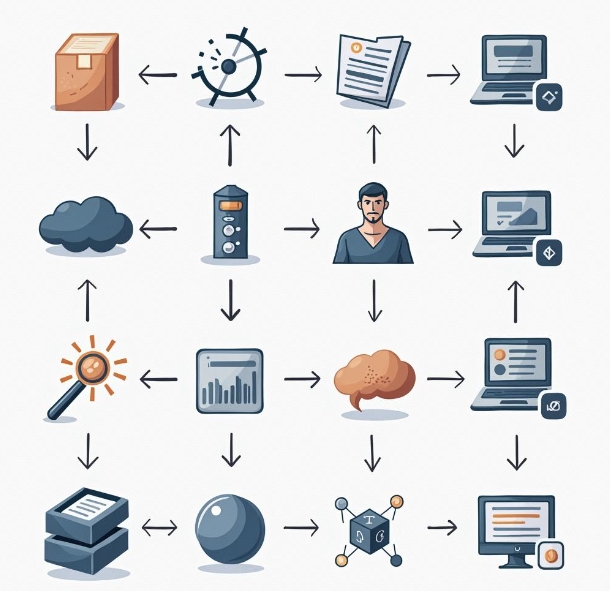AI Model Training: A Key Technology in the Intelligent Era
- latest articles
- 1.DApp Development & Customization: Merging Diverse Market Needs with User Experience 2.Analysis of the Core Technical System in DApp Project Development 3.How to achieve cross-chain interoperability in Web3 projects? 4.How does the tokenization of points reconstruct the e-commerce ecosystem? 5.How to Set and Track Data Metrics for a Points Mall? 6.What is DApp Development? Core Concepts and Technical Analysis 7.Inventory of commonly used Web3 development tools and usage tips 8.Development of a Distribution System Integrated with Social E-commerce 9.Six Key Steps for Businesses to Build a Points Mall System 10.What is DApp Development? A Comprehensive Guide from Concept to Implementation
- Popular Articles
- 1.Future Trends and Technology Predictions for APP Development in 2025 2.Analysis of the DeFi Ecosystem: How Developers Can Participate in Decentralized Finance Innovation 3.From Zero to One: How PI Mall Revolutionizes the Traditional E-commerce Model 4.DAPP Development | Best Practices for Professional Customization and Rapid Launch 5.Recommended by the Web3 developer community: the most noteworthy forums and resources 6.From Cloud Computing to Computing Power Leasing: Building a Flexible and Scalable Computing Resource Platform 7.How to Develop a Successful Douyin Mini Program: Technical Architecture and Best Practices 8.Shared Bike System APP: The Convenient Choice in the Era of Smart Travel 9.How to Create a Successful Dating App: From Needs Analysis to User Experience Design 10.From Design to Development: The Complete Process of Bringing an APP Idea to Life
In today's era of intelligence, the development of artificial intelligence (AI) technology has gradually permeated various industries, driving comprehensive societal transformation. One of the core technologies of AI is model training, especially the training of deep learning models, which has demonstrated immense potential and value in applications such as natural language processing, computer vision, and speech recognition. From basic machine learning to complex deep neural networks, AI model training is not only the cornerstone of technological development in the intelligent era but will also bring more innovations and breakthroughs in the future.
I. Basic Concepts of AI Model Training
The essence of AI model training is to enable machines to learn patterns from large amounts of data, allowing them to make appropriate predictions or decisions when encountering new data. Simply put, AI model training involves computers simulating human thought processes through continuous learning and optimization, gradually improving their ability to handle problems.
1. Machine Learning and Deep Learning
Machine Learning (ML) is an important branch of AI that enables computers to learn automatically from data without explicit programming. Machine learning includes many algorithms, such as decision trees, support vector machines, and K-nearest neighbors, used for different types of data analysis tasks.
Deep Learning (DL) is a subfield of machine learning, particularly focused on training neural networks. Deep learning models typically consist of multi-layer neural networks and possess strong capabilities in data modeling and feature extraction, making them more effective than traditional machine learning methods in handling complex tasks.
2. The Process of Model TrainingAI model training generally follows these steps:
Data Collection and Preprocessing: First, a large amount of high-quality data is required. This data undergoes preprocessing such as cleaning, deduplication, and formatting before entering the training phase.
Selecting the Appropriate Algorithm: Based on the characteristics of the problem, suitable algorithms (such as regression, classification, clustering, etc.) are selected, and a preliminary model is constructed.
Training and Optimization: The model is trained using the training data, and its parameters are adjusted to better fit the data. During this process, the model gradually adjusts its weights through backpropagation algorithms to reduce errors.
Validation and Testing: After training, the model is evaluated using validation and test sets to check its performance on unseen data and avoid overfitting.

II. Key Technologies in AI Model Training
In the process of AI model training, many key technologies and methods play a crucial role. These technologies continuously drive artificial intelligence toward greater intelligence and precision.
1. Neural Networks and Deep LearningThe concept of neural networks originates from the working principles of biological nervous systems. They consist of a large number of neurons (or nodes) and simulate connections between neurons through weights and activation functions. With the improvement in computational power, neural network models have gradually become more complex, giving rise to deep neural networks (DNNs).
Deep neural networks include multiple hidden layers and can automatically extract high-level features from data, greatly enhancing the model's expressive power. Especially in scenarios involving large-scale data and complex tasks, deep learning algorithms demonstrate very strong performance. For example, convolutional neural networks (CNNs) have been successfully applied in image recognition, recurrent neural networks (RNNs) are widely used in speech recognition and natural language processing, and long short-term memory networks (LSTMs) excel in time-series data prediction.
2. Training Methods and Optimization TechniquesThe effectiveness of model training largely depends on optimization algorithms. One of the most commonly used optimization algorithms is gradient descent, which continuously adjusts model parameters along the negative gradient direction of the loss function to find the optimal solution. Additionally, with technological advancements, many new optimization algorithms have emerged, such as stochastic gradient descent (SGD), Adam, and Adagrad. These optimization methods improve training efficiency and model convergence speed by refining parameter update strategies.
3. Data Augmentation and RegularizationIn practical applications, data is often limited, and the performance of AI models is closely related to the amount of data. Data augmentation techniques artificially expand the dataset by applying transformations such as rotation, translation, scaling, and cropping to the training data, thereby improving the model's robustness and generalization ability.
At the same time, regularization techniques can effectively prevent model overfitting. Overfitting occurs when a model performs well on training data but poorly on unseen data, usually due to the model being too complex or insufficient training data. Common regularization methods include L1 and L2 regularization, which penalize model complexity to find the best balance between complexity and fit.
4. Transfer LearningTransfer learning refers to applying a pre-trained model to a new task, which can significantly improve learning efficiency, especially when data is scarce. Through transfer learning, AI systems can leverage knowledge learned from one task to accelerate learning in similar tasks, avoiding the need to train a model from scratch. For example, an image classification model can use transfer learning to apply an image recognition model from one domain to another, greatly reducing training time and computational costs.
III. Challenges and Development Trends in AI Model Training
Although AI model training technology has made significant progress, it still faces many challenges, and future developments remain uncertain.
1. Data IssuesData is the foundation of AI model training, yet the quality and quantity of data are often bottlenecks in model training. Data in many fields remains scarce or incomplete. Additionally, data privacy and security have become critical issues in AI applications. How to obtain high-quality, diverse data while protecting user privacy has become an important topic in AI development.
2. Computational Resource ConsumptionDeep learning models typically require enormous computational resources for training, especially when dealing with large-scale datasets and complex network structures. The consumption of computation time and hardware costs is substantial, which to some extent limits the popularization and application of AI technology. In the future, with the development of hardware devices and the potential of quantum computing, computational efficiency may improve, thereby promoting further applications of AI technology.
3. Interpretability and TransparencyAlthough deep learning models have achieved remarkable results in many tasks, their "black box" nature makes the decision-making process of models lack transparency. Especially in fields such as healthcare and finance, where results require high credibility, model interpretability has become an urgent issue. In recent years, researchers in the AI field have begun to focus on enhancing model interpretability, proposing methods such as LIME and SHAP to help people understand the decision-making process of models.

IV. Summary and Outlook
AI model training is one of the key technologies in the intelligent era. By continuously optimizing and adjusting model parameters, it helps machines learn from data and function in practical applications. With the continuous development of technologies such as deep learning, transfer learning, and optimization algorithms, the efficiency and accuracy of AI model training continue to improve, achieving breakthrough progress in many fields.
However, AI model training still faces challenges related to data, computational resources, interpretability, and more. In the future, with the improvement of computational power and the emergence of new technologies, AI model training will become more intelligent and efficient, achieving broader applications across various industries and driving the arrival of the intelligent era.
-

How does artificial intelligence technology transform the operational models of modern enterprises?
In the wave of the digital era, artificial intelligence (AI) technology has tran···
-

How to Utilize Artificial Intelligence for Precision Medicine and Health Management
With the rapid advancement of technology, artificial intelligence (AI) has demon···
-

Integration and Application of Artificial Intelligence and Robotics
In today's era of rapid technological advancement, the integration of artificial···

 Blockchain
Blockchain










